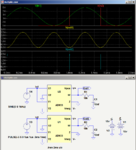preethi19
Full Member level 5
Hi i built a multiplier in cadence and when i give the inputs x,y to be sin wave and having certain amplitude and freq the result say z is doubled in frequency and it works fine for sine wave. Now replacing isin with ipulse or isource in cadence and setting rise and fall time very small and pulse width 10u and period 20u i am able to generate a input square wave for x and y. But the output z is a square wave varying only in amplitude but is in the same frequency as the input and i cant see it doubling in freq when i run transient analysis. I am not changing anything except the input sources. Can anyone pls tell me how to fix this??? Thank you!!!
Last edited:
